Product Images Topiramate
View Photos of Packaging, Labels & Appearance
- image - topiramate usp 1
- Image - topiramate usp 10
- image - topiramate usp 11
- Image Description - topiramate usp 12
- image - topiramate usp 2
- image - topiramate usp 3
- image - topiramate usp 4
- image - topiramate usp 5
- image - topiramate usp 6
- image - topiramate usp 7
- image - topiramate usp 8
- image - topiramate usp 9
Product Label Images
The following 12 images provide visual information about the product associated with Topiramate NDC 53217-274 by Aidarex Pharmaceuticals Llc, such as packaging, labeling, and the appearance of the drug itself. This resource could be helpful for medical professionals, pharmacists, and patients seeking to verify medication information and ensure they have the correct product.
image - topiramate usp 1

This is a titration schedule for the monotherapy treatment of adults and pediatric patients, 10 years and older. The schedule includes increasing doses of 25mg, 50mg, 75mg, 100mg, 150mg, and 200mg, to be taken in the morning and evening over a period of six weeks. These doses are incremental and should only be taken as directed by a healthcare professional.*
Image - topiramate usp 10
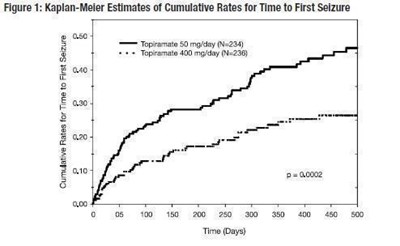
The text is a figure caption with a graph showing the Kaplan-Meler Estimates of Cumulative Rates for Time to First Seizure. The graph compares the rates for patients taking 50 molday of Topramate (N=234) with those taking 400 mojany (4-236). The X-axis represents Time (in days) and the Y-axis represents Cumulative Rates.*
image - topiramate usp 11
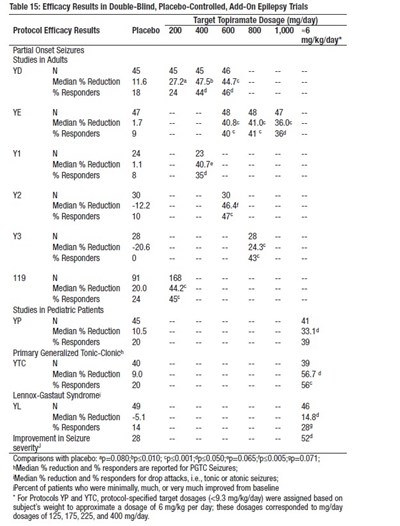
This is a table presenting the results of double-blind, placebo-controlled, add-on epilepsy trials for topiramate, with different dosages ranging from 200 to 1000 mg/day. The table lists the median percentage reduction and percentage responders for different types of seizures, including partial onset seizures and primary generalized tonic-clonic seizures, in adult and pediatric patients. The comparison with the placebo was also reported, as well as the percentage of patients who experienced improvement in seizure severity. Dosage information is also included in the table.*
Image Description - topiramate usp 12
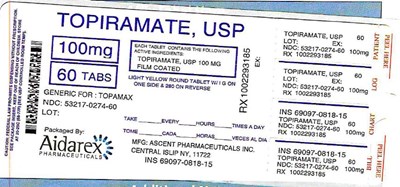
This is a product label for TOPIRAMATE USP 60, 100mg tablets. The tablets are film-coated, yellow, and round with the imprint "ONE SIDE & 280 ON REVERSE". The tablets are used to treat various conditions and come in a bottle of 60 tablets. The manufacturer is Ascent Pharmaceuticals. The label also provides the National Drug Code (NDC) and RX numbers for the product.*
image - topiramate usp 2

This is a table that shows the recommended total daily maintenance dosing for monotherapy treatment in patients aged 2 to under 10 years old based on their weight in kilograms. The table specifies the minimum and maximum maintenance doses based on their weight range. The total daily dose should be administered in two equally divided doses.*
image - topiramate usp 3

This is a table showing the risk of using antiepileptic drugs for different indications. The indications listed are epilepsy, psychiatric, and other. The table shows the number of placebo patients and drug patients, the relative risk, incidence, risk difference with events, and additional drug patients per 1000 patients. For epilepsy, there was a slightly higher risk (RR: 1.0 -> 35/34), with an incidence of 24 events among drug patients, compared to placebo. For psychiatric, the risk was higher (RR: 5.7 -> 85/15), with an incidence of 29 events among drug patients, compared to 5.7 events among placebo patients. For other indications, there was a slightly lower risk (RR: 1.0 -> 19/18), with an incidence of 0.9 events among drug patients, compared to placebo. The last row shows the total statistics for all indications.*
image - topiramate usp 4
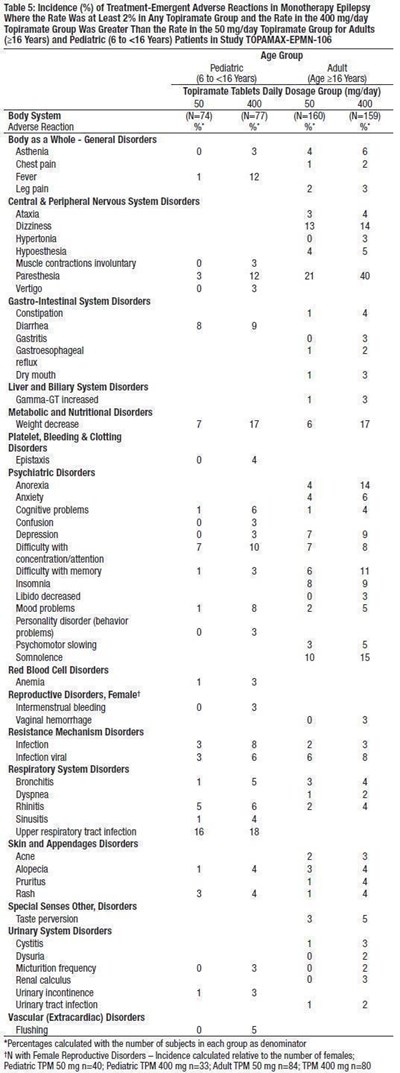
The text provides a Table 5 displaying the incidence of treatment-emergent adverse reactions in monotherapy epilepsy patients where the rate was at least 2% in any Topiramate group and the rate in the 400 mg/day Topiramate group was higher than the rate in the 50 mg/day Topiramate group for adults and pediatric patients in study TOPAMAX-EPMN-106. The table is divided into body system disorders, including general, peripheral and central nervous system, gastro-intestinal, liver and biliary, metabolic and nutritional, platelet, bleeding and clotting, psychiatric, reproductive, resistance mechanism, respiratory, urinary, vascular disorders, and special senses. However, the exact study outcomes or medication details are not available from the text.*
image - topiramate usp 5

The text describes the adverse reactions reported by patients taking topiramate tablets in doses ranging from 200 to 400 mg/day, as part of an add-on/adjunctive therapy for epilepsy, compared to placebo. Adverse reactions are categorized based on the body part/system affected, and the percentage of patients reporting each adverse reaction is listed. The table includes information on 49 different categories of adverse reactions ranging from general and gastrointestinal disorders to special sense and urinatory system disorders. *
image - topiramate usp 6
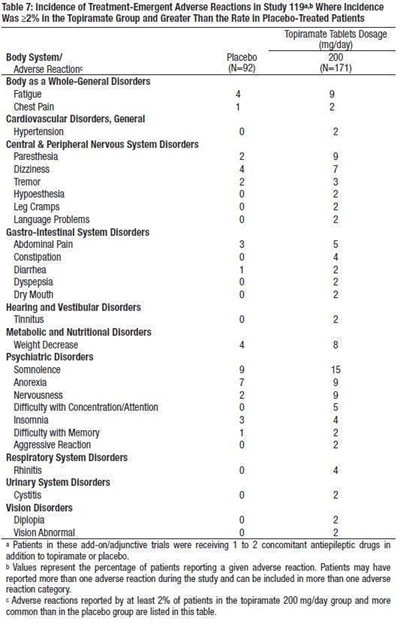
Table 7 shows the incidence of treatment-emergent adverse reactions in Study 119 where the incidence was 2% in the Topiramate group and greater than the rate in Placebo-treated patients. The adverse reactions are categorized by body system and include fatigue, chest pain, hypertension, paresthesia, dizziness, tremor, gastrointestinal disorders, constipation, diarrhea, weight decrease, somnolence, respiratory system disorders, rhinitis, urinary system disorders, vision disorders, and more. Patients in the study were receiving 1 to 2 concomitant antiepileptic drugs in addition to Topiramate or placebo. Values represent the percentage of patients reporting a given adverse reaction. Patients may have reported more than one adverse reaction during the study and can be included in more than one adverse reaction category.*
image - topiramate usp 7
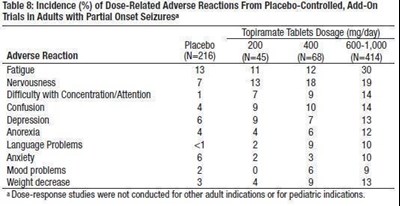
The table shows the incidence of dose-related adverse reactions from placebo-controlled, add-on trials in adults with partial onset seizures for different dosages of Topiramate. The adverse reactions with their corresponding percentages for each dosage are listed. No dose-response studies were conducted for other adult medications or pediatric medications.*
image - topiramate usp 8
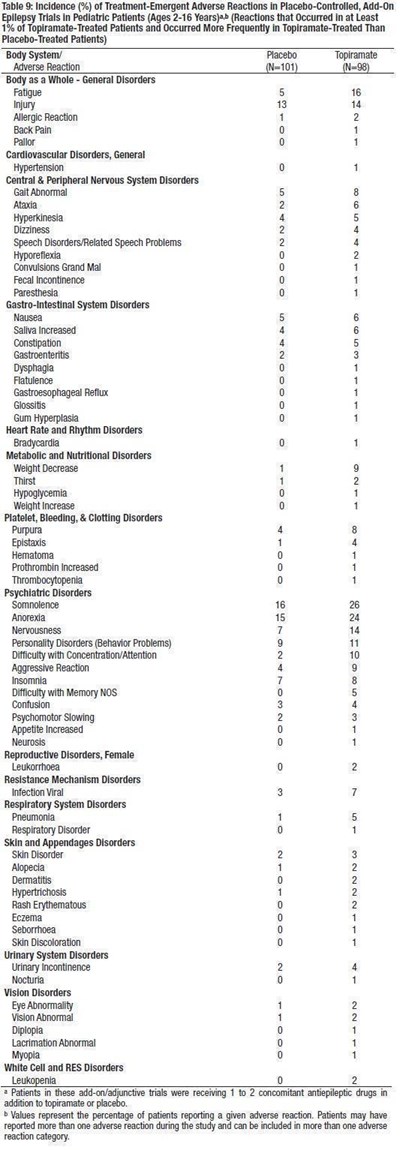
The text describes a table showing the incidence of treatment-emergent adverse reactions in pediatric patients aged 2-16 years with epilepsy. The table shows the adverse reactions that occurred at least 1% in topiramate-treated patients and more frequently than in placebo-treated patients. The adverse reactions are grouped by body system or organ, and percentages of occurrence are provided for each reaction. Some of the reactions reported include fatigue, injury, hypertension, gait abnormality, nausea, constipation, weight change, vision abnormalities, and urinary incontinence. The patients in the study were receiving concomitant antiepileptic drugs in addition to topiramate or placebo.*
* The product label images have been analyzed using a combination of traditional computing and machine learning techniques. It should be noted that the descriptions provided may not be entirely accurate as they are experimental in nature. Use the information in this page at your own discretion and risk.
